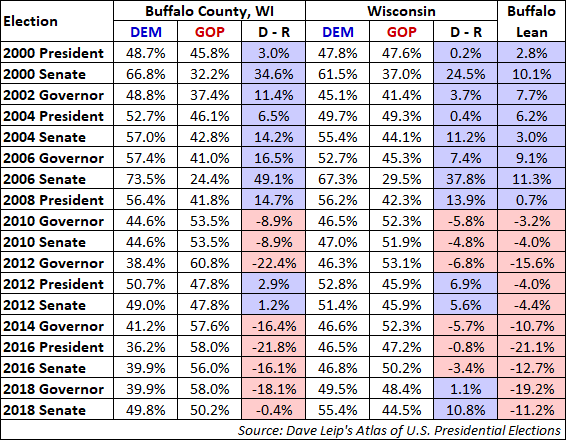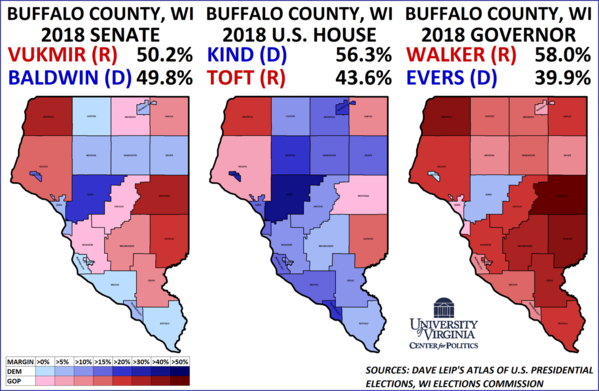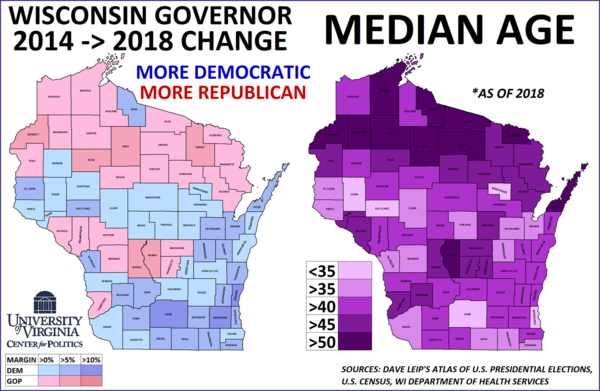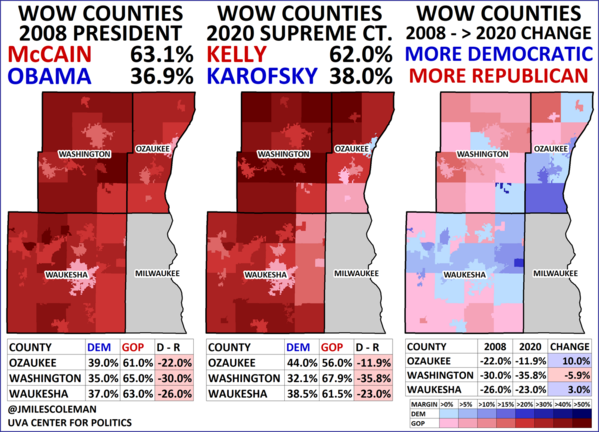States of Play: Wisconsin
A Commentary By J. Miles Coleman
KEY POINTS FROM THIS ARTICLE
— Even without the optics that come from hosting the Democratic National Convention, Wisconsin will be a crucial state this fall.
— Joe Biden’s apparent strength with older voters may buoy him in rural parts of the state, though Donald Trump also may have some room to improve even after his tremendous rural showings four years ago.
— Aside from the presidential contest, the state will see few competitive major races.
Wisconsin: Arguably 2020’s most vital state
As we closed out 2019, one of the Crystal Ball’s final pieces of the year looked at what could be the pivotal state this year: Wisconsin. At the time, we noted that one reason the state would be central to the 2020 campaign was that it was slated to hold the Democratic National Convention. Well, almost exactly eight months later, here we are — former Vice President Joe Biden secured the Democratic nomination at Tuesday’s roll call, and is set to address delegates, virtually, tonight.
While the COVID-19 pandemic effectively took some of the national limelight away from the state, Wisconsin’s electoral stature is undiminished — even without the pageantry of a Milwaukee convention, the state’s 10 electoral votes are paramount to each side’s strategy.
Wisconsin in the 21st century
In three of the five presidential elections this century — 2000, 2004, and 2016 — Wisconsin was among the most hotly-contested states in the Electoral College. In 2000, Al Gore carried the state with 47.8% to 47.6% for George W. Bush. By percentage margin, it was the third-closest state in the country that year, behind only Florida and New Mexico. A notable third presence on the ballot was Green Party candidate Ralph Nader, who took 2.7% nationally and a larger 3.6% in Wisconsin.
With Nader’s left-leaning stances, it would be logical to assume that, in his absence, Gore would have carried the state with more breathing room. But in 2004, third parties took less than 1% of the vote in Wisconsin, and the result was still on a knife’s edge. John Kerry kept it in the Democratic column by a 49.7% to 49.3% vote over Bush — this time, it was the closest percentage margin in the country. Kerry’s showing in the state roughly matched Gore’s, though there were some differences: the Fox River Valley and much of central Wisconsin got redder, but Kerry made up for that with gains in the north. (Map 1)
Map 1: Wisconsin, 2000-2004
In a contemporary context, the type of movement that northern Wisconsin saw would seem counterintuitive, as the area has gotten more GOP-leaning since (though we’ll look later at why it could again see some blue shifts in 2020). Still, broadly speaking, the partisan coalitions from the early 2000s still show up in statewide races. Democrats have a base in Milwaukee, Madison’s Dane County — plus a handful of smaller counties in its orbit — and can usually win a string of counties along the state’s western border, known as the “Driftless Area.” In the very northern extreme of the state, Douglas, Bayfield, and Ashland counties touch Lake Superior and are, politically, rare: they’re largely white working class territory, but still vote reliably blue.
The traditional heart of the state GOP coalition is in the southeast. Waukesha, Ozaukee, and Washington counties — known to political junkies as the “WOW” counties (we’ll have more on this area later) — were Bush’s three best counties. North of the WOW counties, Republicans tend to carry most eastern counties — the city of Ripon, where the Republican Party was founded in 1854, is located in this area — and the rural northern counties, which are more sparsely-populated, are often varying shades of red.
So, all things considered, Wisconsin’s geography seems like a recipe for a purple state. But, sometimes, its electorate can lurch sharply towards either extreme. Such was the case in 2008.
That year, Wisconsin was not particularly competitive, and neither was the national popular vote. At the national level, 2020 is currently looking like it could be a similar type of cycle. As of Aug. 18, Biden held an average lead of 7.7 percentage points in national polling — in 2008, the Obama-Biden ticket won the popular vote by a very comparable 53%-46%. In the Badger State, that translated to an easy 56%-42% win for Obama, a 14-point spread that was essentially double his national margin. If Biden can ultimately replicate Obama’s popular vote showing, it seems like his margin in Wisconsin may not be as plush — his average lead there is 6.5 percentage points, or slightly right of where he polls nationally. In 2016, Hillary Clinton won nationally by two points while losing Wisconsin by a little less than a point, meaning that the state voted three points to the right of the nation.
Why might Biden struggle to replicate Obama’s Wisconsin performance, even if his popular vote margin is just as robust? As Chuck Todd and Sheldon Gawiser point out in their post-2008 book How Barack Obama Won, while Obama was a demographically unique candidate — given his race, age, and background — the significance of his home region can sometimes get overlooked.
For decades, the Midwest has been the prime bellwether region in presidential elections. Obama’s home state of Illinois is, of course, safely blue, but in three states that border it — Iowa, Indiana, and Wisconsin — his 2008 margins represented double-digit improvements over what John Kerry received in 2004. In other words, Obama may have been able to overperform with voters in this electorally-significant region simply because he was “one of them.” Obama’s 2008 margin in Wisconsin was likely padded further by some of the national Republicans’ tactics — in mid-October, they essentially conceded the state, as John McCain’s campaign (unsuccessfully) prioritized Pennsylvania. The Midwest can also sometimes tire of foreign wars; Iraq fatigue may have hurt the Republicans in 2008 (and perhaps Trump’s criticism of Bush-era foreign policy also helped him in the region).
In November 2012, Wisconsin again voted left of the country, as Obama held it 53%-46%, compared to his 51%-47% overall. Down the ballot, its voters made history by electing the first openly LGBT senator, as they gave then-Rep. Tammy Baldwin (D, WI-2) a promotion. But just a few months earlier, the state’s electoral landscape looked more red. After his 2010 election, Gov. Scott Walker (R-WI), along with a Republican legislature, passed a litany of conservative reforms, most notably Act 10, which was aimed at curtailing the influence of unions. State Democrats organized, and a June 2012 gubernatorial recall election was set.
Walker survived the recall 53%-46%, the exact margin by which Obama would go on to carry the state by. Exit polling suggested that the governor benefited from Democrats’ perceived overreach: most voters, 60%, thought recall elections were appropriate only in cases of official misconduct. Walker was certainly divisive, but voters clearly didn’t think his actions rose to that level, so he received something of a sympathy bonus. Indeed, exit polling also showed that 18% of Walker’s votes planned to support Obama in the fall. So over the span of five months in 2012, Wisconsin elected leaders from both ends of the ideological spectrum — a good summation of how volatile its politics is.
For 2016, though Wisconsin ultimately ended up picking the president, its primary results were notably less prescient. Historically, the Badger State primary is highly significant in presidential politics: in 1960, it gave John F. Kennedy a crucial win over Hubert Humphrey for the Democratic nomination. A decade and a half later, both Jimmy Carter and Gerald Ford claimed hard-fought victories there in 1976. In 2008, it was a post-Super Tuesday contest that helped cement both Obama and McCain as mathematical favorites on their sides. On the 2012 Republican calendar, Rick Santorum’s loss there prompted his exit from the campaign, paving the way for Mitt Romney’s nomination. In 2016, Badger State primary voters found themselves in an unusual, contrarian position: they picked two losers. Anti-Trump forces, marshaled in part by radio host Charlie Sykes, rallied in Wisconsin to give Sen. Ted Cruz (R-TX) a 48%-35% victory over the future GOP nominee. On the Democratic side, Hillary Clinton carried only one county, Milwaukee, against Sen. Bernie Sanders (I-VT).
Despite her primary loss — in retrospect, her primary weakness in the northern and western areas of the state should have been a major warning — Clinton’s campaign didn’t make any general election visits to the state, which may have hurt her prospects there. While she fared well in parts of the Madison and Milwaukee metro areas, in 45 of the state’s 72 counties, she saw double-digit drops in her percentage share compared to what Obama received four years earlier. Trump, by contrast, posted numbers in some rural counties that were truly historic. In Marinette County, a northeastern county which was a bustling lumber port in its heyday, Trump’s 33% margin was the best spread for a Republican candidate since Warren Harding, in 1920.
So what may be different in Wisconsin for 2020? Before we look at some regional trends, there’s one broader trend worth remembering: as we wrote back in May, we expect third party candidates will do worse across the board this year. In 2016, Donald Trump and Hillary Clinton combined for just 93.7% of the vote in Wisconsin, a two-party figure that should certainly rise this year. The third party picture in Wisconsin is still a little murky, although there should be more clarity later today — as of now, the Libertarians appear to be on track to make the ballot, but the Greens (and rapper Kanye West) may not make it.
The reduced third party presence in the state this time will make a repeat of Trump’s 2016 performance — when he carried the state with a 47.2% plurality — a bit harder. That’s not to say winning the state again will be impossible for him. As we saw between 2000 and 2004, even as the third party share plunged in the state, the overall result was the same.
Micro-level trends
As the national electorate has gotten more polarized over recent elections, the number of bellwether counties has dwindled. In the context of Wisconsin, several rural counties that used to track closely to the statewide results have zoomed rightward, as the Democratic coalition has come to rely more on voters in metropolitan areas. In western Wisconsin, along the Minnesota border, Buffalo County fits this bill — from 2000 to 2016, it picked the correct statewide winner in every presidential, senatorial, and gubernatorial race. But in 2018, it leaned well to the right, as it voted markedly more Republican than the state. (Table 1)
Table 1: Buffalo County, WI 2000-2018
2018 was, broadly, described as a blue wave year, but in Buffalo County, things looked a lot like 2016. As now-Gov. Tony Evers (D-WI) ousted Walker in the 2018 gubernatorial race, he took the exact same 39.9% that former Sen. Russ Feingold (D-WI) earned in his ill-fated 2016 comeback bid. The “Buffalo Lean” column in Table 1 also suggests that Buffalo County’s realignment preceded the Trump era. Before 2010, the county would typically vote a few points left of the state, but a decade later, Democrats need to be winning the state by significant margins to even come close there.
At the congressional level, Wisconsin only has one remotely competitive district: the 3rd District, which has been held for over 20 years by moderate Democrat Ron Kind (D, WI-3). Despite the marginal nature of the district — it favored Obama twice, then flipped to Trump by about 4.5 percentage points in 2016, and supported Walker three times before narrowly abandoning him in 2018 — Kind has all but locked down this seat (the Crystal Ball rates it as Likely Democratic). Buffalo County, which sits entirely in his WI-3, also serves as a great example of Kind’s strength. As Baldwin fell just short of carrying it in her 2018 reelection effort, voters there remained faithful to Kind, as he won the county 56%-44%. (Map 2)
Map 2: Buffalo County, WI in 2018
Buffalo County, like much of northern Wisconsin, has a population that skews older than the rest of the state (as of 2018, the state’s median age was 39.3). Recent polling has shown Biden performing relatively well with senior voters, a potentially promising sign for him in this otherwise red-trending region. August polling from the Marquette University Law School, which surveys the state frequently, gave Biden a 49%-44% lead over Trump, while he held an even greater 53%-41% lead with voters over 60 years old. For some context, 2016 exit polling gave Trump a very slight 49%-48% lead with voters over 65 in Wisconsin.
Extrapolating county-level trends from polling is always a bit tenuous, but if Biden’s lead with senior voters endures, he’d likely see some improvement in northern Wisconsin, given the demographics. This trend would be a departure from some previous cycles. Between his last two gubernatorial runs, even when Walker went from a 52%-46% win in 2014 to a narrow loss in 2018, he improved in wide swaths of the north. As Map 3 illustrates, many of the oldest counties swung to Walker, while counties that are relatively young (lighter purple) tended to shift more Democratic.
Map 3: Wisconsin 2014-2018 swing, median age
Of course, there were some exceptions to the correlation that Map 3 indicates. Door County, a relatively old county that, geographically, sticks out into Lake Michigan, is an example. It’s been billed as among the nation’s best retirement areas and it is a popular vacation destination — though with its peninsular geography, Door County’s residents and businesses seem especially concerned about climate change, an issue that may be nudging its electorate leftward.
Looking at just the 2014 to 2018 partisan swing picture on Map 3, it also disproves a common Republican tagline: that state Democrats only appeal to voters in Madison and Milwaukee. Evers did well in both cities — earning 83% in the former and 78% in the latter — but the trend lines suggest that Walker’s standing with his base voters had eroded somewhat. Specifically, the two counties that moved most against him were actually both in the WOW region. In Ozaukee County, he performed 14% worse than 2014, and Waukesha County moved 12% more Democratic. Since Walker’s first primary run, in 2010, he could count on robust support in the area (before he was governor, he was Milwaukee County Executive for eight years, so voters in the region knew him well). Walker still took a hefty majority in Waukesha County, but in such a close race, having his vote share drop from 72.5% to 66% proved costly.
Indeed, it’s hard to discuss Wisconsin’s political geography without bringing up the WOW counties. While Democrats have flipped demographically similar counties across the county into the blue column, the WOW counties have remained loyally red. Still, in other elections — aside from Walker’s races — there have been some signs that the three counties may not stay monolithically GOP.
In 2008, as Obama carried the state by 56%-42%, he lost the three WOW counties by an aggregate 63%-37%. More recently, in April, we dissected returns from the state Supreme Court race, where judge Jill Karofsky won by 11%. Judicial elections in Wisconsin are nominally nonpartisan, but Karofsky was endorsed by Democrats, while her opponent, Daniel Kelly, had GOP support. Compared to Obama’s showing a dozen years ago, Karofsky fared slightly better in the WOW counties, but there were some unmistakable internal shifts (Map 4).
Map 4: WOW counties, 2008 vs 2020
It’s apparent that southern Ozaukee County is acting more like an inner suburb of Milwaukee, with its sharp blue swing. In 2008, Obama didn’t carry a single whole municipality between the three counties, but by 2020, Karofsky carried Port Washington (right under the “Ozaukee” label on the middle map). Washington County, as the most exurban of the trio, actually got about 6% more Republican between the elections. Waukesha County, which is by far the most populous of the group (with just over 400,000 residents), was something of a mixed bag — it was slightly more blue in 2020, but most of the swing followed Interstate 94, which splits the county horizontally, and connects Madison to Milwaukee.
All this isn’t to say that the WOW counties will be voting blue this year, or any time soon. Rather, it’s to show that realignment is occurring even in the most historically partisan areas. In fact, it’s possible that Trump could even improve in the area. In 2016, he carried Waukesha County just 60%-34% while, down the ballot, Sen. Ron Johnson (R-WI) won it 68%-30% in his successful reelection effort. In the 2016 presidential primary, the WOW counties powered Ted Cruz’s 13% victory over Trump in Wisconsin — Cruz cleared 60% in all three counties. By November 2016, it’s easy to see how some Cruz supporters may have voted for Gary Johnson, who took 4% in the WOW counties, on the Libertarian line.
But by now, Cruz’s former voters have had four years to warm up to the president. So even if Trump loses the state this year, he may still perform more like a generic Republican in the WOW counties. On the other hand, any further slippage in these counties would jeopardize his chances of carrying the state again, as we saw with Walker.
In a state like Wisconsin, every little shift may matter. Obama’s big 2008 and 2012 victories papered over the state’s competitiveness. It may be that no single state is as likely to vote for the eventual Electoral College winner as Wisconsin.
J. Miles Coleman is an elections analyst for Decision Desk HQ and a political cartographer. Follow him on Twitter @jmilescoleman.
See Other Political Commentary by J. Miles Coleman.
See Other Political Commentary.
This article is reprinted from Sabato's Crystal Ball.
Views expressed in this column are those of the author, not those of Rasmussen Reports. Comments about this content should be directed to the author or syndicate.
Rasmussen Reports is a media company specializing in the collection, publication and distribution of public opinion information.
We conduct public opinion polls on a variety of topics to inform our audience on events in the news and other topics of interest. To ensure editorial control and independence, we pay for the polls ourselves and generate revenue through the sale of subscriptions, sponsorships, and advertising. Nightly polling on politics, business and lifestyle topics provides the content to update the Rasmussen Reports web site many times each day. If it's in the news, it's in our polls. Additionally, the data drives a daily update newsletter and various media outlets across the country.
Some information, including the Rasmussen Reports daily Presidential Tracking Poll and commentaries are available for free to the general public. Subscriptions are available for $4.95 a month or 34.95 a year that provide subscribers with exclusive access to more than 20 stories per week on upcoming elections, consumer confidence, and issues that affect us all. For those who are really into the numbers, Platinum Members can review demographic crosstabs and a full history of our data.
To learn more about our methodology, click here.





